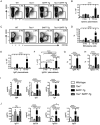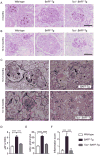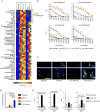TACI deletion protects against progressive murine lupus nephritis induced by BAFF overexpression
- PMID: 29907458
- PMCID: PMC6151274
- DOI: 10.1016/j.kint.2018.03.012
TACI deletion protects against progressive murine lupus nephritis induced by BAFF overexpression
Abstract
B cells are known to promote the pathogenesis of systemic lupus erythematosus (SLE) via the production of pathogenic anti-nuclear antibodies. However, the signals required for autoreactive B cell activation and the immune mechanisms whereby B cells impact lupus nephritis pathology remain poorly understood. The B cell survival cytokine B cell activating factor of the TNF Family (BAFF) has been implicated in the pathogenesis of SLE and lupus nephritis in both animal models and human clinical studies. Although the BAFF receptor has been predicted to be the primary BAFF family receptor responsible for BAFF-driven humoral autoimmunity, in the current study we identify a critical role for signals downstream of Transmembrane Activator and CAML Interactor (TACI) in BAFF-dependent lupus nephritis. Whereas transgenic mice overexpressing BAFF develop progressive membranoproliferative glomerulonephritis, albuminuria and renal dysfunction, TACI deletion in BAFF-transgenic mice provided long-term (about 1 year) protection from renal disease. Surprisingly, disease protection in this context was not explained by complete loss of glomerular immune complex deposits. Rather, TACI deletion specifically reduced endocapillary, but not mesangial, immune deposits. Notably, although excess BAFF promoted widespread breaks in B cell tolerance, BAFF-transgenic antibodies were enriched for RNA- relative to DNA-associated autoantigen reactivity. These RNA-associated autoantibody specificities were specifically reduced by TACI or Toll-like receptor 7 deletion. Thus, our study provides important insights into the autoantibody specificities driving proliferative lupus nephritis, and suggests that TACI inhibition may be novel and effective treatment strategy in lupus nephritis.
Keywords: B-cell activating factor of the TNF family (BAFF); autoantibodies; lupus nephritis; systemic lupus erythematosus; transmembrane activator and CAML interactor (TACI).
Copyright © 2018 International Society of Nephrology. Published by Elsevier Inc. All rights reserved.
Figures






Similar articles
-
Integrated B Cell, Toll-like, and BAFF Receptor Signals Promote Autoantibody Production by Transitional B Cells.J Immunol. 2018 Dec 1;201(11):3258-3268. doi: 10.4049/jimmunol.1800393. Epub 2018 Oct 29. J Immunol. 2018. PMID: 30373855 Free PMC article.
-
TACI haploinsufficiency protects against BAFF-driven humoral autoimmunity in mice.Eur J Immunol. 2021 Sep;51(9):2225-2236. doi: 10.1002/eji.202149244. Epub 2021 Jun 27. Eur J Immunol. 2021. PMID: 34146342 Free PMC article.
-
Deleting the BAFF receptor TACI protects against systemic lupus erythematosus without extensive reduction of B cell numbers.J Autoimmun. 2015 Jul;61:9-16. doi: 10.1016/j.jaut.2015.04.007. Epub 2015 May 29. J Autoimmun. 2015. PMID: 26027434
-
The BAFF/APRIL system: emerging functions beyond B cell biology and autoimmunity.Cytokine Growth Factor Rev. 2013 Jun;24(3):203-15. doi: 10.1016/j.cytogfr.2013.04.003. Epub 2013 May 15. Cytokine Growth Factor Rev. 2013. PMID: 23684423 Free PMC article. Review.
-
TACI, an enigmatic BAFF/APRIL receptor, with new unappreciated biochemical and biological properties.Cytokine Growth Factor Rev. 2008 Jun-Aug;19(3-4):263-76. doi: 10.1016/j.cytogfr.2008.04.006. Epub 2008 Jun 2. Cytokine Growth Factor Rev. 2008. PMID: 18514565 Review.
Cited by
-
Integrated B Cell, Toll-like, and BAFF Receptor Signals Promote Autoantibody Production by Transitional B Cells.J Immunol. 2018 Dec 1;201(11):3258-3268. doi: 10.4049/jimmunol.1800393. Epub 2018 Oct 29. J Immunol. 2018. PMID: 30373855 Free PMC article.
-
B Cells in Systemic Lupus Erythematosus: From Disease Mechanisms to Targeted Therapies.Rheum Dis Clin North Am. 2021 Aug;47(3):395-413. doi: 10.1016/j.rdc.2021.04.006. Epub 2021 Jun 16. Rheum Dis Clin North Am. 2021. PMID: 34215370 Free PMC article. Review.
-
Lymphocytes Change Their Phenotype and Function in Systemic Lupus Erythematosus and Lupus Nephritis.Int J Mol Sci. 2024 Oct 10;25(20):10905. doi: 10.3390/ijms252010905. Int J Mol Sci. 2024. PMID: 39456692 Free PMC article. Review.
-
Renal Tissue Expression of BAFF and BAFF Receptors Is Associated with Proliferative Lupus Nephritis.J Clin Med. 2022 Dec 22;12(1):71. doi: 10.3390/jcm12010071. J Clin Med. 2022. PMID: 36614872 Free PMC article.
-
BAFF inhibition in SLE-Is tolerance restored?Immunol Rev. 2019 Nov;292(1):102-119. doi: 10.1111/imr.12810. Epub 2019 Sep 28. Immunol Rev. 2019. PMID: 31562657 Free PMC article. Review.
References
-
- Mackay F, Schneider P. Cracking the BAFF code. Nature reviews Immunology. 2009;9:491–502. - PubMed
-
- Gavin AL, Duong B, Skog P, et al. deltaBAFF, a splice isoform of BAFF, opposes full-length BAFF activity in vivo in transgenic mouse models. J Immunol. 2005;175:319–328. - PubMed
-
- Stohl W, Metyas S, Tan SM, et al. B lymphocyte stimulator overexpression in patients with systemic lupus erythematosus: longitudinal observations. Arthritis and rheumatism. 2003;48:3475–3486. - PubMed
Publication types
MeSH terms
Substances
Grants and funding
LinkOut - more resources
Full Text Sources
Other Literature Sources

